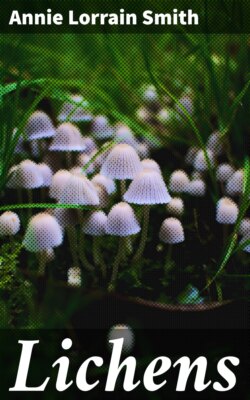Читать книгу Lichens - Annie Lorrain Smith - Страница 69
3. FRUTICOSE AND FILAMENTOUS A. General Structure of Thallus
ОглавлениеThe conditions of strain and tension in the upright plant are entirely different from those in the decumbent thallus, and to meet the new requirements, new adaptations of structure are provided either in the cortex or in the medulla.
Cortical Structures. With the exception of the distinctly plectenchymatous cortex, all the other types already described recur in fruticose lichens; in various ways they have been modified to provide not only covering but support to the fronds.
a. The fastigiate cortex. This reaches its highest development in Roccella in which the branched hyphal tips, slightly clavate and thick-walled, lie closely packed in palisade formation at right angles to the main axis (Fig. 45). They afford not only bending power, but give great consistency to the fronds. The cortex is further strengthened in R. fuciformis[375] by the compact arrangement of the medullary hyphae that run parallel with the surface, and among which occur single thick-walled filaments. The plant grows on maritime rocks in very exposed situations; and the narrow strap-shaped fronds, as stated above, may attain a length of 30 cm., though usually they are from 10 to 18 cm. in height. The same type of cortex, but less highly differentiated, affords a certain amount of stiffness to the cylindrical much weaker fronds of Thamnolia.
b. The fibrous cortex. This type is found in a number of lichens with long filamentous hanging fronds. It consists of parallel hyphae, rarely septate and rarely branched, but frequently anastomosing and with strongly thickened “sclerotic” walls. Such a cortex is the only strengthening element in Alectoria, and it affords great toughness and flexibility to the thong-like thallus. It is also present in Ramalina (Alectoria) thrausta, a species with slender fronds (Fig. 60).
Fig. 60. Alectoria thrausta Ach. A, transverse section of frond; a, cortex; b, gonidia; c, arachnoid medulla × 37. B, fibrous hyphae from longitudinal section of cortex. × 430 (after Brandt).
In Usnea longissima the cortex both of the fibrillose branchlets and of the main axis is fibrous, and is composed of narrow thick-walled hyphae which grow in a long spiral round the central strand. The hyphae become more frequently septate further back from the apex (Fig. 61). Such a type of cortex provides an exceedingly elastic and efficient protection for the long slender thallus.
Fig. 61. Usnea longissima Ach. Longitudinal sections of outer cortex. A, near the apex; B, the middle portion of a fibril. × 525 (after Schulte).
The same type of cortex forms the strengthening element in the fruticose or partly fruticose members of the family Physciaceae. One of these, Teloschistes flavicans, is a bright yellow filamentous lichen with a somewhat straggling habit. The fronds are very slender and are either cylindrical or slightly flattened. The hyphae of the outer cortex are compactly fibrous; added toughness is given by the presence of some longitudinal strands of hyphae in the central pith.
Another still more familiar grey lichen, Physcia ciliaris, has long flat branching fronds which, though dorsiventral in structure, are partly upright in habit. Strength is secured as in Teloschistes by the fibrous upper cortex. Other species of Physciae are somewhat similar in habit and in structure.
In Dendrographa leucophaea, a slender strap-shaped rock lichen, Darbishire[376] has described the outer cortex as composed of closely compacted parallel hyphae resembling the strengthening cortex of Alectoria and very different from the fastigiate cortex of the Roccellae with which it is usually classified.
